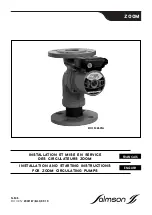
Varisco S.p.A.
Z.I. Nord - Terza Strada, 9 - 35129 PADOVA – ITALY
Tel.+39.049.8294111 Email: [email protected]
Fax+39.049.8076762 Web: www.variscospa.com
18
3. Remove the screws holding outlet flange (04) and the housing (05) (bearing housing or close
coupled housing pumps) to the base (06).
4. Remove the oulet flange by taking off the nuts and their washers.
5.
Loosen the nuts and screw out the tie rods (07).
6. Remove the second foot (08) if present.
7. Extract the stator from the rotor by slowly turning the stator and pulling in the direction of
the black arrow (see below) until they were completely free.
9.1.1 CERAMIC ROTOR
Ceramic rotors require particular care and no force of any kind. In particular, hammer strikes,
concussions and collisions are to be avoided.
When the stator is extracted out of a ceramic rotor, the latter must be held to prevent it from
toppling downwards and hitting the body edge (09), thus suffering damage.
The rotor shall not collide with the pump body under any circumstances. Struck parts become
critical, and could trigger early failures.
9.2 ROTOR-STATOR RE-ASSEMBLY
1. Before re-assembly, it is necessary to carefully clean visible and disassembled parts.
2. Insert the stator on the rotor, lubricating it with glycerine, vaseline or neutral silicon oil.
Assembly is carried out as described in Chap 9.1, with reversed order of operations.
3. The operation is completed by re-inserting the pump body, stator, tie rods and pipe union.
NOTE: Certain types of stators have at their end an integrated sealing profile.
In this case no O-Ring washers are needed (see picture Chap. 9.1.1), neither at the union side nor at
the pump body side. In any other case, they shall be replaced every time the parts are disassembled.
WARNING: Do not tighten the pump body threaded cap too strongly (11) (pic. Chap. 9.1.1), since
its cone-shaped thread could damage the pump body itself. The tightening torque is about 40-50
Nm. Do not over-tighten screws and tie rods. See table below:
Screw Dia M6 M8 M10 M12 M16 M20 M24 M30
Torque
(Nm)
8 15
30 45 75 80 100
12










































